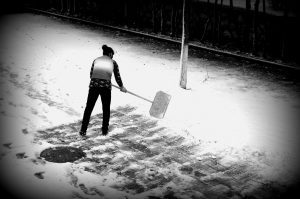Snow Shovelling Safety

Unfortunately, winter is just around the corner, and with it, inevitably comes snow.
Although this can be fun to play in, it can be a laborious chore to move and at times
can be dangerous and risky.
Today I hope to give you some pointers on better ways to shovel your snow and protect
yourself while doing it.
Besides for car accidents, and slip and falls, snow shoveling is one of the more common
causes of back injuries when the snow falls.
Here are some tips to help you get through this wonderful Canadian chore.
Start with the right shovel for you.
Not all shovels are the same, and not all shovels work for all people.
Advances in recent years have made shovels lighter, stronger and more ergonomic.
Shovel size is a very important factor. Standard handle lengths are not usually appropriate
for all members of the family. Taller people need longer handles than their shorter family
members. This can sometimes be solved with adjustable length handles or potentially
multiple shovels.
The size and material of the of the shovel matter as well. A strong plastic
shovel is lighter but usually requires more force, whereas an aluminium shovel has low
weight and stronger ability to scrape and push.
The size of the shovel is important as well. A larger width is great for pushing snow, and
reducing time, but when it is full it could take considerable effort to lift. A smaller shovel will
take longer but reduces the heavy load of lifting snow especially when the snow is wet.
An ergonomic snow shovel can help take some of the effort out of snow removal. Curved
handles can help reduce strain and effort.
Warm up and stretch before and during shovelling
When it’s cold our muscles tighten up and get short and more prone to strains. Trying to
warm up and stretch inside before going out is a smart plan. When outside make sure to
dress warmly in water resistant clothing and be sure to wear a hat.
During shovelling, especially in heavy snowfalls, take some time and stretch part way
through to stay warm. Also make sure to move in to the reverse positions from how you
shovel (back bends, leg stretches, etc).
Before going out, do some brisk walking inside or outside, maybe some light jumping jacks
or jogging on the spot.
Stretch your back and hamstrings and stretch your arms by hugging yourself and reaching
your arms straight back.
Use Ergonomic Lifting Techniques
Lifting is the hardest part of shovelling, so wherever and whenever possible try to push the
snow to one side. If you have a large area to clear, try to divide the area in to sections
(halves or quarters) that you can push to an area first. The larger the line you push, the
heavier and more resistance there will be.
When there is no more room to push and it becomes necessary to lift the snow, make sure
to do this as safely and ergonomically as possible:
– Face the snow and keep your hips and shoulders square to the snow you are about to lift.
– Only put as much in the shovel as you can easily lift at one time. This may mean
more shovel loads, but much less strain on your body.
– Make sure to bend your knees and keep your low back straight. This requires the use of
your glute (buttock) and Quad (thigh) muscles.
– Make sure to do the lifting with your legs.
– Try to put one hand as low on the shovel as comfortably possible – The closer the hand is
to the blade the less load on the body
– Keep the shovel central and square to your body to move snow. Try not to twist or throw
the snow, but step and lift/drop.
– If the banks are getting high, move the snow to another location by walking it over.
Throwing or tossing the snow is very strenuous
– Try to alternate which arm is the top and which is the bottom through your removal
process.
Pace Yourself
The snow isn't going anywhere so take your time. When you shovel small amounts at a
time, it is much less strenuous than moving large amounts at one time.
For deeper snow, it is easier to remove it in small sections and by taking a percentage off
the top first and then lower down after. Trying to move the whole depth at once can be very
strenuous.
Take breaks. It is important to rest for a couple of minutes every 10-15 minutes during
shovelling. This however is dependent on your fitness level, so if you feel tired or fatigued,
take a break, rest, stretch, etc and then go back to it.
Watch your footing.
Always be sure to where proper warm footwear with a good tread. Slippery conditions can
lead to slip and falls so the better your grip the less chance of falling.
Test the ground before you start shovelling. Check to see if there are icy or slippery spots
before shovelling to reduce the likelihood of slipping and falling.
If Possible, Stop Shoveling – Use a Snow Blower Instead.
Stay safe this winter and keep these guidelines in mind while clearing the snow off your
walkways and driveways.
If however the unfortunate happens and you do hurt yourself, please contact us at Apple
Creek Sports Medicine for excellent advice and treatment, so we can help get you back up
and going before the next snowfall.
Jordan Katz HBa(Kine) MSc.PT, MCPA
Registered Physiotherapist
